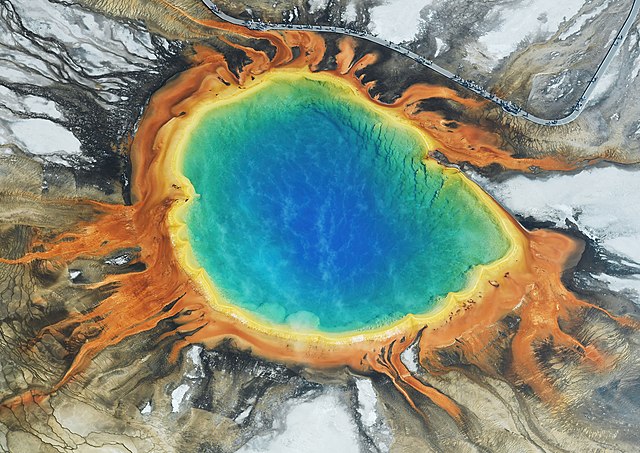Extremophiles are remarkable microorganisms that thrive in extreme conditions on Earth, environments that were once considered inhospitable to life. The discovery and study of extremophiles have expanded our understanding of the diversity of life and have important implications for astrobiology, the search for extraterrestrial life, and biotechnology. Here are some examples of extremophiles and the extreme environments they inhabit:
Thermophiles:
- Habitat: Thermophiles thrive in high-temperature environments, such as hot springs, hydrothermal vents on the ocean floor, and volcanic regions.
- Notable Example: Thermus aquaticus, a thermophilic bacterium, produces the heat-resistant enzyme Taq polymerase, which revolutionized the field of DNA amplification (PCR).

Aerial image of Grand Prismatic Spring (view from the south)
Acidophiles:
- Habitat: Acidophiles are adapted to highly acidic environments, such as acid mine drainage, sulfuric acid pools, and acid volcanic lakes.
- Notable Example: Acidithiobacillus ferrooxidans is used in the mining industry to extract metals from ores by oxidizing sulfide minerals.
Alkaliphiles:
- Habitat: Alkaliphiles thrive in alkaline (high pH) environments, such as soda lakes and alkaline soils.
- Notable Example: Natronomonas pharaonis is a microorganism found in soda lakes with an alkaline pH of around 11.
Halophiles:
- Habitat: Halophiles flourish in highly saline environments, including salt flats, salt mines, and hypersaline lakes.
- Notable Example: Halobacterium salinarum is an extremophile archaeon found in salt lakes, known for its ability to produce proteins that function in high salt concentrations.
Psychrophiles:
- Habitat: Psychrophiles are cold-loving organisms that inhabit polar ice, glaciers, and deep-sea environments.
- Notable Example: Psychrobacter cryohalolentis is found in permanently cold Arctic permafrost.
Piezophiles (Barophiles):
- Habitat: Piezophiles thrive in high-pressure environments, such as the deep ocean trenches and sub-surface sediments.
- Notable Example: Photobacterium profundum, a barophile, is found in the Mariana Trench and has adaptations for life under extreme pressure.
Radiotolerant Microbes:
- Habitat: Some extremophiles can withstand high levels of radiation, such as Deinococcus radiodurans, which is resistant to ionizing radiation and desiccation.
Anaerobes:
- Habitat: Anaerobic extremophiles thrive in environments devoid of oxygen, such as deep subsurface rocks and sediments, as well as the human gut.
- Notable Example: Methanogens, a type of anaerobic archaea, produce methane gas and are found in anaerobic environments.
These extremophiles have adapted to their extreme habitats through various mechanisms, including specialized enzymes, protective cell membranes, and unique metabolic pathways. The study of extremophiles not only expands our knowledge of life on Earth but also informs the search for life in extreme environments on other planets and moons, such as Mars, Europa, and Enceladus. Additionally, extremophiles have practical applications in biotechnology, including the development of enzymes for industrial processes and bioremediation of polluted environments.











